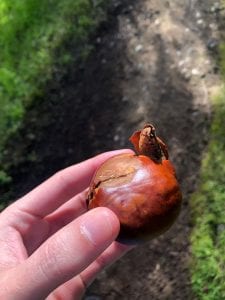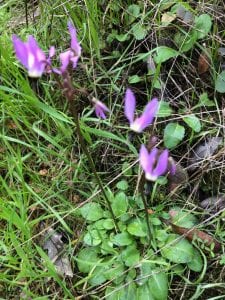Location: Mount Tamalpais, Natalie Coffin Greene Park, Yolonda trail
Hello Everyone! This week’s blog post was definitely an interesting one! We’ve moved a little bit from the coastal areas of California to a bit more inland. As a result, we can really see a change in the landscape! This environment reminds me a bit more of what an actual forest looks like. The soil has a bit more nutrients in it and fresh water runs freely down creeks into a phoenix lake. Trees such as live Oaks, deciduous black oaks and the occasional redwoods took up much larger portions of the land than in our previous field trips. Unfortunately, in some areas of our hike, invasive French’s broom had completely taken over. Many places along the hike had so much French’s broom that the thicket was smothering all else beneath it. However, even though French’s broom is still a problem today, some local ecological restoration efforts have made it possible for local grasses and plants to regrow where the thickets of French’s broom once were. In addition, Dr.Paul made us climb up a steep large hill to see some cool really tiny flowers! This wasn’t just any hiking trip, it was an extreme hiking trip!
When I was a little kid, I loved watching TV (and still do today). However, I sometimes wonder if I hadn’t watched all that TV, would I have had some extra brainpower to deal with O-Chem or evolution etc. At least all that TV gave me a topic to talk about in this blog post. Out of all the mind-numbing TV I watched, one of the most memorable shows was called the power puff girls. Long story short, it was basically a show about three chemically synthesized little girls who have superpowers and beat up an evil little green monkey with a very large hat. I swear the show seems better when you actually watch it and not when I describe it. Anyways, the reason why I’m bringing it up in this post is because each plant I present in today’s post will represent the main characters! Blossom, buttercup, and bubbles were their names so get ready for a Power Puff Girl Themed post Everyone!
****
Blossom
Here is blossom! She is the leader of the group and the most well rounded and even-keeled of the whole group. As a result, I have chosen the California Buckeye (Aesculus californica) to represent her! Although the California Buckeye’s flowers are not traditionally seen as blossoms, they kind of resemble blossoms to me. Blossom flowers are usually defined as any flower that gives rise to fruit with a stone in the center. Even though the California Buckeye’s fruit is not technically a stone, it sure looks like it is!
California buckeyes seem more like generic trees to me since they aren’t especially tall. However, just like Blossom, they can be quite deadly! If eaten by humans, their seeds are quite toxic. In addition, honeybees will actually die if they take pollen and nectar from this tree. Many California farmers are sure to never put their apiaries anywhere near a California buckeye. In addition, native Americans actually grounded up the seeds of this tree and through it into ponds in order to kill all of the fish inside. It turns out these deadly plants have large quantities of saponin inside most of their tissues. In addition to having detergent-like properties, saponins are cytotoxic chemicals which mess with cholesterol’s ability to upkeep the integrity of the cellular membrane. As a result, saponins cause cell permeabilization, particularly in erythrocytes.
Plant Description: The California Buckeye grows to be between 4 and 12 meters. The leaves of the plant have a very characteristic compound palmate arrangement to them. The margins of the leaves are very finely serrate with an acute apex. The overall shape of the leaf is roughly oblong. Although not currently in bloom, these plants have a panicle-like inflorescence with a rose pink to white color. They have 5 – 7 stamens with orange anthers. Despite the small flower size, their fruits can be up to 9 centimeters in diameter. Their seeds are glossy brown in appearance and equally as large.
****
Buttercup
So here’s Buttercup! She’s the more aggressive beat stuff up kind of girl. Funnily enough, even though she shares her name with this delicate flower, she is not delicate at all. Other than that, buttercups don’t really have much else going for them. Native Americans used to include their seeds in Pinole, a sort of flour like concoction. I hear they can also be eaten if you toast them and put them in baked goods. If you do eat these plants, make sure you toast them hot enough! They are toxic otherwise.
Note: This photo was not mine. Sorry, I had a hard time uploading this one!
Plant description: This plant grows to be between 11 and 18 centimeters tall. The leaves are 3 lobed with 1 lobe being ternate. Their margins are generally toothed and sometimes they can appear serrate. The perianth of the flower has 5 sepals, with 9 -17 petals. The petals curve to form a cup like shape. The fruit is disk-like with thick, smooth walls.
****
Bubbles
Bubbles is the third and final power puff girl! As her name suggests, she is very bubbly, kind and sweet. Unfortunately, there is no flower named bubbles that I know of. As a result, I just decided to use the most bubbly plant that I saw on our trip, the shooting star (Primula hendersonii). Bubbles takes a while to come out of her shell and so does this plant. It usually takes the plant 2-3 years to develop a root system before it is ready to flower. Also if you look at the flower just right, it looks like you’ve just seen a shooting star! Feel free to make a wish! I personally wished for a million more wishes. I suggest you do the same. It’s basically the first rule of summoning a genie so the same rule should apply to shooting stars. Make sure you come to see them before the summer though! They are summer deciduous perennial herbs. If you’re wondering why this flower looks like a shooting star, its because the sepals actually open up away from the flower until they form that needle like thing. Interestingly, these plants are also some of the earliest flowering plants.
Plant Description: These particular shooting stars had glabrous stems that extended to around 20 centimeters. Sometimes they can actually get to be as tall as 40 centimeters though. These leaves have entire margins with an elliptical to obovate blade. The petals and sepals come in pairs of 4 or 5. The petal lobes are 6 to 23 mm and they typically have a deep lavender color. Their fruits are circumscissile which means that they dehisce along a fissure in its capsule.
Here’s one last parting picture.
See you guys next week!









